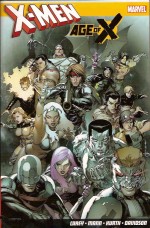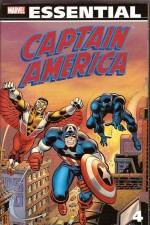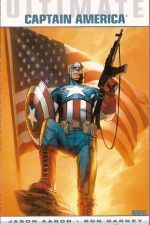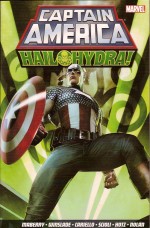
By Roy Thomas, Steve Englehart, Wally Wood, Keith Giffen & various (Marvel)
ISBN: 978-1-9041-5973-5
Prince Namor, the Sub-Mariner was the second super-star of the Timely Age of Comics (but only because he followed after the cover-featured Human Torch in Marvel Mystery Comics #1) and has had the most impressive longevity of the company’s “Big Three†Torch, Subby and Captain America.
He was revived in 1962 in Fantastic Four #4; once again an anti-hero/noble villain and has been prominent in the company’s pantheon ever since.
The following issue introduced the first great villain of the Silver Age in the form of technologically armoured dark knight Doctor Doom, who takes up the lion’s share of this eclectic yet excellent collection of dastardly double-dealings encompassing Astonishing Tales #1-8, Giant-Sized Super-Villain Team-Up #1-2, Super-Villain Team-Up #1-14 and 16-17, as well as pertinent crossover appearances in Avengers #154-156 and Champions 16.
Incidentally, Fantastic Four #6 featured the first Super-Villain Team-Up of the Marvel age as Doom and Namor joined forces as ‘The Deadly Duo’. The Master of Latveria inevitably betrayed and tried to kill the Prince of Atlantis in that tale: an event which colours the relationship of the characters to this day… All of those magical moments appear in Essential Fantastic Four volume 1, by the way.
Although Doom had his first true solo outing in Marvel Super-Heroes #20 (May 1969) this magnificent and monumental monochrome collection opens with his follow-up series which began with ‘Unto You is Born… the Doomsman!’ (July-August 1970) wherein Roy Thomas & Wally Wood revealed the master manipulator’s daily struggle to maintain his iron control over the Ruritanian kingdom of Latveria, building a super-robot to crush the incipient rebellion of ousted Crown Prince Rudolfo and his mysterious sponsor.
However the use of a girl who seemed to be Victor von Doom’s lost love had the desired effect and the rebels almost succeeded in driving the tyrant from Doom Castle. In the attendant chaos the Doomsman device wandered away…
‘Revolution!’ proved Doom was not the only master of mechanoids as Rudolfo and the enigmatic Faceless One used the Doomsman to wreak havoc throughout the country, before a final assault in ‘Doom Must Die!’ (scripted by Larry Lieber) found all the tyrant’s enemies vanquished and the Monarch of Menace once more firmly in control.
Lieber & Wood then pitted Doom against the Red Skull in ‘The Invaders!’ as an army of leftover Nazis stormed into the country whilst Doom was away, only to be crushed and banished in ‘A Land Enslaved!’ (Astonishing Tales #5, by Lieber, George Tuska & Mike Esposito) as soon as he came back.
Issue #6 saw the Lord of Latveria invade the African nation of Wakanda in ‘The Tentacles of the Tyrant!’ determined to seize the vast stock of wonder mineral Vibranium only to fall foul of the furious tenacity of its king and defender T’Challa the Black Panther in ‘…And If I be Called Traitor!’ (Gerry Conway, Gene Colan & Frank Giacoia).
The short solo run ended in high style with a little landmark entitled ‘Though Some Call it Magic!’, wherein Conway, Colan & Tom Palmer revealed Doom’s darkest secret. Every year the ultimate villain was forced to duel the rulers of Hell in the vain hope of freeing the soul of his mother from eternal torment, and every year he failed: a tragic trial which punished both the living and the dead.
With this tormented mini-epic even further depth and drama were added to the greatest villain in the Marvel universe.
The series vanished with no warning and Doom returned to his status as premier antagonist in the Fantastic Four and elsewhere until Giant-Sized Super-Villain Team-Up #1 was released (March 1975), once more bathing the Deadly Despot in a starring spotlight.
In the intervening years the Sub-Mariner had also lost his own series, despite some very radical and attention-grabbing stunts. A nerve gas dumping accident perpetrated by surface dwellers had catastrophically altered his hybrid body, forcing him to wear a hydrating-suit to breathe. The same toxin had plunged the entire nation of Atlantis into a perpetual coma.
Alone and pushed to the brink of desperation, Prince Namor rescued Doom from a deadly plunge to Earth after the Iron Dictator’s latest defeat the hands of the FF and Silver Surfer in an impressive and effective framing sequence bracketing two classic reprint tales. ‘Encounter at Land’s End!’ (by Roy Thomas, John Buscema & Joe Sinnott) saw Doom plucked from the sea and the edge of death by a Sub-Mariner in dire need of scientific wizardry to cure his somnolent race and prepared to offer an alliance against all mankind to get it…
Painfully aware of their unhappy past history the outlaws recalled a previous encounter ‘In the Darkness Dwells Doom!’ (from Sub-Mariner #20, by Thomas, Buscema & Johnny Craig) wherein the fugitive Atlantean was offered sanctuary in New York’s Latverian embassy before being blackmailed and betrayed (again) by the Devil Doctor…
Initially reluctant, Doom reconsiders after recalling a past battle against the diabolical Diablo. ‘This Man… This Demon!’ (Thomas, Lieber, Giacoia & Vince Colletta) is the aforementioned solo tryout from Marvel Super-Heroes #20, which restated the Doctor’s origins and revealed his tragic, doomed relationship with a gypsy girl named Valeria…
The debate ends in a cataclysmic clash of egos and raw destructive power with both parties more bitterly opposed than ever but the follow-up ‘To Bestride the World!’ (Thomas, Mike Sekowsky & Sam Grainger) in the all-new Giant-Sized Super-Villain Team-Up #2 (June 1975), forced Doom to change his mind when his own android army rebelled after the long-lost Doomsman (under its new guise of Andro) returned and co-opted them for a war against organic life.
After blistering battle and extensive carnage Namor and Doom triumphed together and parted uneasy allies, only to regroup in the pages of Super-Villain Team-Up #1 (August 1975) as a chaotic ongoing series began with ‘Slayers from the Sea!’ by Tony Isabella, George Tuska, Bill Everett & Fred Kida.
As Doom actually contemplates treating an ally as a equal in the opening chapter ‘An Alliance Asunder?’, in the second part ‘Frenzy on a Floating Fortress’ (illustrated by George Evans & Frank Springer) Namor is ambushed by old foes Attuma, Dr. Dorcas and Tiger Shark, leading Doom to rush to his rescue in #2 as ‘In the Midst of Life…!’ (with art from Sal Buscema & Kida) the Sub-Mariner’s truest friend was murdered by his assembled enemies, leading to a brutal climax in ‘If Vengeance Fails!’ by Jim Shooter, Evans & Jack Abel.
Super-Villain Team-Up was an intriguing concept cursed with a revolving door creative team crisis: nobody seemed able to stay with the series for more than a couple of issues. Somehow the standards remained high but with no long-term planning the plots and characterisation jumped all over the place.
Bill Mantlo, Herb Trimpe & Jim Mooney produced ‘A Time of Titans!’ in #4 as Doom and Sub-Mariner battled each other and encountered a prototype Deathlok the Demolisher before splitting up yet again, after which Steve Englehart stepped in for ‘…And Be a Villain!’ (illustrated by Trimpe & Don Perlin) wherein the Lord of Latveria artificially exacerbated Namor’s breathing affliction and threatened to annihilate dormant Atlantis. Despite all the efforts of the Fantastic Four the Sub-Mariner was forced to swear fealty to Doom or see his people and himself perish forever…
This tumultuous issue also introduced mystic Batman knock-off the Shroud whose avowed mission was to free the world from the curse of Doom at all costs…
Jack Abel inked ‘Prisoner!’ in #6 as the FF invaded Latveria to rescue the promise-bound Sub-Mariner only to be sent packing by US Secretary of State Henry Kissinger who had just signed a non-aggression pact with Doom. One American observed no such legal or diplomatic niceties in ‘Who is… The Shroud?’ (Pablo Marcos inks) and, after revealing his origins to Namor, the Master of Darkness freed him from his vow by killing Dr. Doom.
As Shroud and Namor fled for the border chaos broke out in Latveria, but in actuality Doom was not dead. He had been rescued and imprisoned by Namor’s cousin Namorita and girlfriend Tamara in ‘Escape!’ (illustrated by Keith Giffen & Owen McCarron) under the misguided apprehension that they could force the Metal-shod Monarch into helping Atlantis and their Prince., The crisis escalated as it segued into an ongoing Avengers storyline, beginning ‘When Strikes Attuma?’ (Avengers #154 by Conway, George Perez & Marcos) as the Sub-sea Slayer enslaved the World’s Mightiest Heroes and commanded them to kill Namor…
The saga continued in Super-Villain Team-Up #9 (scripted by Mantlo, drawn by Jim Shooter & Sal Trapani) as the ‘Pawns of Attuma!’ attacked only to discover Doom in charge and easily able to thwart their half-hearted assault. In Avengers #155 the beaten heroes were helpless, leaving only the confused, battle-crazed Namor and a substitute team to hunt down the barbarian sea lord, with the epic conclusion ‘The Private War of Doctor Doom!’ in #156 (written by Shooter, drawn by Sal Buscema & Marcos) where the liberated and resurgent heroes joined forces to crush Attuma and prevent Doom from turning the situation to his own world-conquering advantage…
Behind the scenes in Latveria, Shroud had installed Prince Rudolfo as a faux Doctor Doom but things went wrong very quickly in Super-Villain Team-Up #10 (by Mantlo, Bob Hall & Perlin) when Captain America investigated ‘The Sign of the Skull!’
In the Latverian Embassy the genuine despot learned from the Star-Spangled Avenger that Red Skull had once more invaded Doom’s homeland, even as the Sub-Mariner discovered greedy surface-men pillaging his comatose city of Atlantis.
As Doom and Captain America battled their way through Latveria’s formidable defences the Skull proceeded in establishing his Fourth Reich, easily defeating the Shroud in ‘My Ally, my Enemy’ but when Namor raged in, tracking the ravagers of Atlantis to Doom’s castle, the tables were finally turned and the Iron Dictator swore to finally cure the Atlanteans in return for the Sub-Mariner’s aid against the Nazi invaders.
Firstly though, the Skull plans to enslave the earth with a hypno-ray had to be crushed in ‘Death Duel!’ with the Iron Doctor pursuing the Nazi mastermind to his hidden moonbase, casually sacrificing the Shroud in the process.
Finally fulfilling his oath Doom resurrected the comatose Atlanteans in #13, but only after a blistering sub-sea battle with amphibian arch-foe Krang and a brobdingnagian sea beast in ‘When Walks the Warlord!’ (by Mantlo, Giffen & Perlin)
With Atlantis and Namor restored a new era began and ended with Super-Villain Team-Up #14 (October 1977). ‘A World For the Winning!’ by Mantlo, Hall, Perlin & Duffy Vohland, opened with mutant villain Magneto tricked into a duel with Doom who was de facto master of the world since he had seeded the atmosphere with a mind control gas.
Ever the sportsman, the Lord of Latveria released Magneto from his control, allowed him to liberate one other thrall and challenged them both to save the world…
It was the last issue of the troubled title and the story concluded in Champions #19 (November 1977) as the Master of Magnetism and the Beast spectacularly overcame all odds and saved the day in ‘A World Lost!’ (Mantlo, Hall & Mike Esposito). A year later Super-Villain Team-Up #15 appeared from nowhere (dated November 1978 and presumably released to safeguard the copyright) with a reprint of the Red Skull story from Astonishing Tales #4-5.
‘Shall I Call Thee Master?’ by Peter Gillis, Carmine Infantino & Bruce Patterson was released a year later ( #16 May 1979, with one final issue 12 months after that) wherein the Skull, Hatemonger and radical geneticist Arnim Zola whiled away the days in a human atrocity lab. This was a dark exploration of monstrous inhumanity where torture and degradation were simply a way of passing the time until the leftover Fascists could build a new Cosmic Cube and reshape all reality to their twisted whims.
In this instance they were thwarted by merely mortal secret agents in the long delayed but savagely effective conclusion ‘Dark Victory!’ (Gillis, Arvell Jones & Patterson), after which the concept and title were shelved for decades.
This eccentric and thoroughly fan-only compendium concludes with a double page spread omitted from earlier reprintings of ‘This Man… This Demon!’ and the rather magnificent cover of that tale from Marvel Super-Heroes #20.
For all its flaws Super-Villain Team-Up was a bold experiment and a genuinely enjoyable dalliance with the different during the 1970s – as long as the reader had an in depth knowledge of the company’s ever- more complex continuity. I truly wish more people would sample the delights of this offbeat saga but I doubt any new reader could cope with the terrifying torrent of unexplained backstory.
Still, I’d be delighted if you prove me wrong…
© 1970, 1971, 1975, 1976, 1977, 2008 Marvel Characters, Inc. All Rights Reserved.










